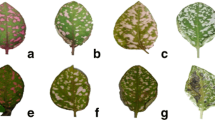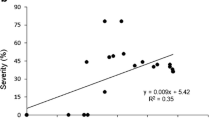Abstract
The response of phenolic compounds as a result of long-term low open-field ozone exposure was studied in ozone-sensitive and ozone-tolerant clones of European silver birch (Betula pendula Roth). The saplings were exposed to 1.5–1.6 times the ambient (elevated) ozone and ambient air (as control) over three growing seasons from May 1996 until August 1998. Quantification by modified Folin-Ciocalteau assay showed a 16.2% increase in total phenolics in elevated ozone plants as compared to that in controls and a corresponding 9.9% increase of 10 phenolic compounds quantified by HPLC. Five nonflavonoids and five flavonoids showed 8.4% and 11.4% increases, respectively. The phenolic results indicated slightly higher ozone sensitivity of clone 5 as compared to clone 2. The most ozone-responsive phenolic compounds in clone 2 and clone 5 were (+)-catechin (CT), chlorogenic acid (CGA), 5-p-coumaroylquinic acid (5CQA), 3-p-coumaroylquinic acid (3CQA), myricetin galactopyranoside (MG), quercetin-3-O-glucuronopyranoside (QGR), and quercetin-3-O-arabinofuranoside (QA). Increased phenolic content in ozone-exposed plants was related to impaired growth and accelerated leaf senescence, indicated by enhanced autumn leaf yellowing and lower chlorophyll and Mg content. The change in carbon allocation towards defensive phenolics at the expense of growth was greater in the ozone-sensitive clone as compared to tolerant clone.
Similar content being viewed by others
REFERENCES
APPEL, H. M. 1993. Phenolics in ecological interactions: The importance of oxidation. J. Chem. Ecol. 19:1521-1552.
BENNETT, R. N., and WALLSGROVE, R. M. 1994. Secondary metabolites in plant defence mechanisms. New Phytol. 127:617-633.
BRYANT, J. P., CHAPIN, F. S., III, and KLEIN, D. R. 1983. Carbon-nutrient balance of boreal plants in relation to vertebrate herbivory. Oikos 40:357-368.
BRYANT, J. P., CHAPIN, F. S., III, REICHARDT, P. B., and CLAUSEN, T. P. 1987. Response of winter chemical defence in Alaska paper birch and green alder to manipulation of plant carbon/nutrient balance. Oecologia 72:510-514.
DIXON, R. A., and PAIVA, N. L. 1995. Stress-induced phenylpropanoid metabolism. Plant Cell 7:1085-1097.
ELSTNER, E. F., OSSWALD, W., VOLPERT, R., and SCHEMPP, H. 1994. Phenolic antioxidants. Acta Holticl. 381:304-335.
FOY, C. D., LEE, E. H., ROWLAND R., DEVINE, T. E., and BUZZELL, R. I. 1995. Ozone tolerance related to flavonol glycoside genes in soybean. J. Plant Nutr. 18:637-647.
GEZELIUS, K., and HALLEN, M. 1980. Seasonal variation in ribulose bisphosphate carboxylase activity in Pinus sylvestris. Physiol. Plant. 48:88-98.
GIERTYCH, M. J., KAROLEWSKI, P., and DE TEMMERMAN, L. O. 1999. Foliage age and pollution alter content of phenolic compounds and chemical elements in Pinus nigra needles. Water Air Soil Pollut. 110:363-377.
GRACE, S. C., LOGAN, B. A., and ADAMS, W. W., III. 1998. Seasonal differences in foliar content of chlorogenic acid, a phenylpropanoid antioxidant, in Mahonia repens. Plant Cell Environ. 21:513-521.
HERMS, D. A., and MATTSON, W. J. 1992. The dilemma of plants: to grow or defend. Q. Rev. Biol. 67:283-335.
JONES, C. G., and HARTLEY, S. E. 1998. Global change and plant phenolic concentrations: species level predictions using the protein competition model, pp. 23-50, L. J. De Kok and I. Stulen (eds.). in Responses of Plant Metabolism to Air Pollution and Global Change. Backhuys Publishers, Leiden, The Netherlands.
JORDAN, D. N., GREEN, T. H., CHAPPELKA, A. H., LOCKABY, B. G., MEHLDAHL, R. S., and GJERSTAD, D. H. 1991. Response of total tannins and phenolics in loblolly pine foliage exposed to ozone and acid rain. J. Chem. Ecol. 17:505-513.
JULKUNEN-TIITTO, R., and MEIER, B. 1992. Variation in growth and secondary phenolics among field-cultivated clones of Salix myrsinifolia. Planta Med. 58:77-80.
KEINäNEN, M., and JULKUNEN-TIITTO, R. 1998. High-performance liquid chromatographic determination of flavonoids in Betula pendula and Betula pubescens leaves. J. Chromatogr. A 793:370-377.
LANGENHEIN, J. H. 1994. Higher plant terpenoids: A phytocentric overview of their ecological roles. J. Chem. Ecol. 20:1223-1280.
LARSON, R. A. 1988. The antioxidants in higher plants. Phytochemistry 27:969-978.
LAVOLA, A. 1998. Phytochemicals of deciduous trees in relation to environmental changes. PhD thesis. University of Joensuu, Publications in Sciences No. 46, 39 pp.
LAVOLA, A., JULKUNEN-TIITTO, R., and PääKKöNEN, E. 1994. Does ozone stress change the primary or secondary metabolites of birch (Betula pendula Roth)? New Phytol. 126:637-642.
MATYSSEK, R., and INNES, J. L. 1999. Ozone-a risk factor for forest trees and forests in Europe? Water Air Soil Pollut. 116:199-226.
OKSANEN, E., and SALEEM, A. 1999. Ozone exposure results in various carry-over effects and prolonged reduction in biomass in birch (Betula pendula Roth). Plant Cell Environ. 22:1401-1411.
ORMROD, D. P., LANDRY, L. G., and CONKLIN, P. L. 1995. Short-term UV-B radiation and ozone exposure effects on aromatic secondary metabolite accumulation and shoot growth of flavonoiddeficient Arabidopsis mutants. Physiol. Plant. 93:602-610.
OSSIPOV, V., NURMI, K., LOPONEN, J., PROKOPJIEV, N., HAUKIOJA, E., and PIHLAJA, K. 1995. HPLC isolation and identification of flavonoids from white birch Betula pubescens leaves. Biochem. Syst. Ecol. 23:213-222.
OSSIPOV, V., NURMI, K., LOPONEN, J., HAUKIOJA, E., and PIHLAJA, K. 1996. High performance liquid chromatographic separation and identification of Betula pubescens and Betula pendula. J. Chromatogr A 721:59-68.
PääKKöNEN, E., PAASISALO, S., HOLOPAINEN, T., and KäRENLAMPI, L. 1993. Growth and stomatal responses of birch (Betula pendula Roth.) clones to ozone in open-air and chamber fumigations. New Phytol. 125:615-623.
PORRA, R. J., THOMPSON, W. A., and KREIDEMANN, P. E. 1989. Determination of accurate extinction coefficients and simultaneous equations for assaying chlorophylls a and b extracted with four different solvents: verification of the concentration of chlorophyll standards by atomic absorption spectroscopy. Biochem. Biophys. Acta 975:384-394.
RICE-EVANS, C. A., MILLER, N. J., and PAGANGA, G. 1997. Antioxidant properties of phenolic compounds. Trends Plant Sci. 2:152-159.
RICHTER, C. A., and WILD, A. 1988. Phenolic compounds in needles of Norway spruce trees in relation to novel forest decline. I. Studies on trees from a site in the northern Black Forest. Biochem. Physiol. Pflanzen 188:305-320.
RINTAMäKI, E., KEYS, A. J., and PARRY, M. A. J. 1988. Comparison of the specific activity of ribulose-1,5-bisphosphate carboxylase-oxygenase from some C3 and C4 plants. Physiol. Plant. 74:326-331.
ROSEMANN, D., HELLER, W., and SANDERMANN, H. JR., 1991. Biochemical plant responses to ozone. II. Induction of stilbene biosynthesis in Scots pine (Pinus sylvestris L.) seedlings. Plant Physiol. 97:1280-1286.
SEGAL, I. H. 1975. Biochemical Calculations. John Wiley & Sons, New York.
SKäRBY, L., RO-POULSEN H., WELLBURN, F. A., and SHEPPARD, L. 1998. Impact of ozone on forests: a European perspective. New Phytol. 139:109-122.
WATERMAN, P. G., and MOLE, S. 1994. Analysis of Phenolic Plant Metabolites. Blackwell Scientific Publications, London, pp. 83-84.
WELLBURN, A. R., and LICHTENTHALER, H. 1984. Formulae and program to determine total carotenoids and chlorophylls a and b of leaf extracts in different solvents. pp. 9-12, in C. Sybesma (ed.). Advances in Photosynthesis Research, Vol II.
WELLBURN, F. A. M., and WELLBURN, A. R. 1996. Variable patterns of antioxidant protection but similar ethene emission differences in several ozone-sensitive and ozone tolerant plant sections. Plant Cell Environ. 19:754-760.
WULFF, A., HäNNINEN, O., TUOMAINEN, A., and KäRENLAMPI, L. 1992. A method for open-air exposure of plants to ozone. Ann. Bot. Fenn. 29:253-262.
Author information
Authors and Affiliations
Rights and permissions
About this article
Cite this article
Saleem, A., Loponen, J., Pihlaja, K. et al. Effects of Long-Term Open-Field Ozone Exposure on Leaf Phenolics of European Silver Birch (Betula pendula Roth). J Chem Ecol 27, 1049–1062 (2001). https://doi.org/10.1023/A:1010351406931
Issue Date:
DOI: https://doi.org/10.1023/A:1010351406931




